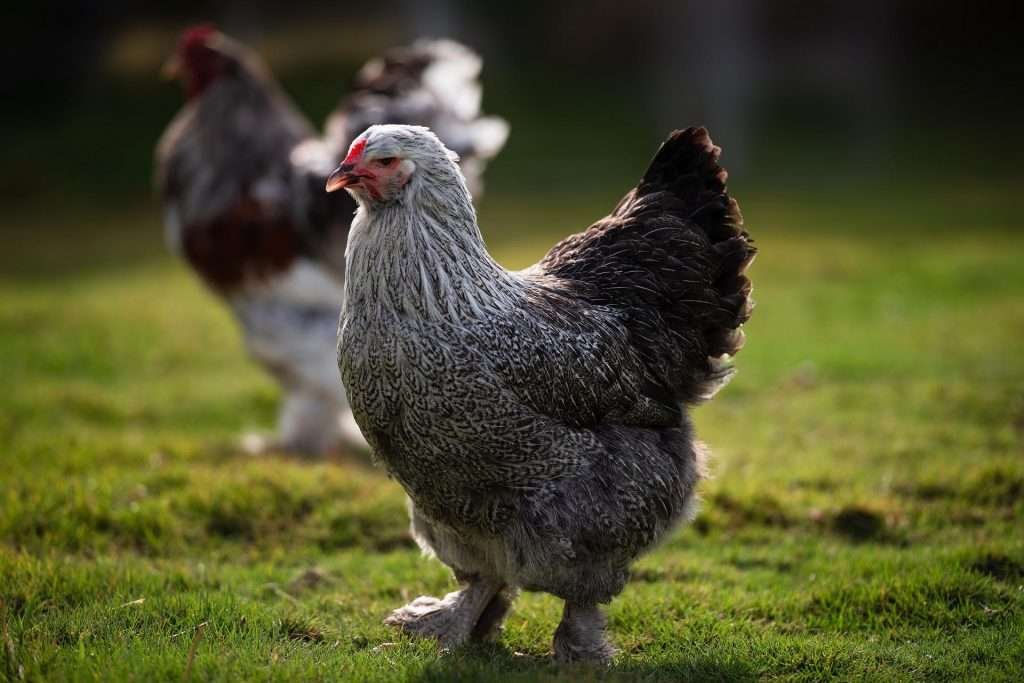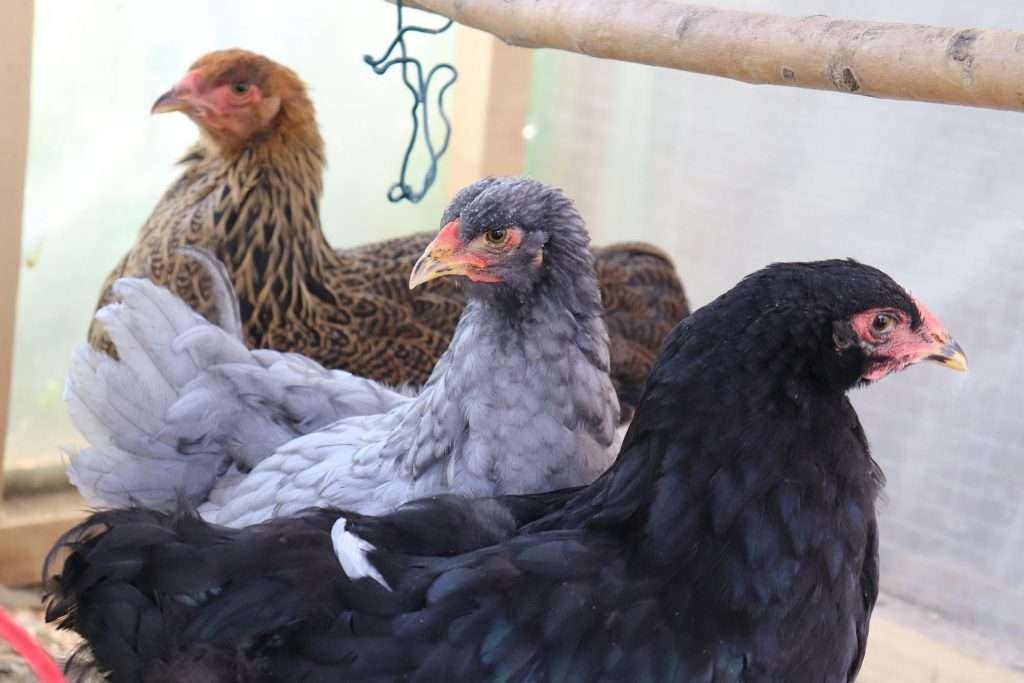If you are looking for a larger breed of chicken that is docile, excels at laying eggs and is also suitable for meat, then the Brahma chicken is likely a great choice to add to your flock!

Brahma chickens are known as gentle giants. They are a large chicken breed and are a popular choice for egg production and for meat supply.
Our comprehensive and detailed overview of this breed will inform you of the characteristics of the Brahma chicken and enable you to decide whether they are the perfect addition to your flock.
What this article covers
This is a long article, so below are some quick links. Click any of them to go straight to that section – or just carry on reading for the full guide!
Overview of Brahma characteristics
Pros and Cons of Brahma Chickens
Personality of a Brahma Chicken
Appearance of a Brahma Chicken
Nutrition Needs of a Brahma Chicken
How much Coop Space does a Brahma Chicken need?
Shopping list of items needed to look after a Brahma chicken
Overview of Brahma characteristics
| Lifespan | 8+ years |
| Weight | 8 lb (hens) 10 lb (roosters) |
| Color | Dark, light and buff |
| Egg Production | 3-4 per week. |
| Egg Color | Brown |
| Broody | No |
| Noisy | No |
| Suitable for hot environments | No |
| Suitable for cold environments | Yes |
| Suitable for wet environments | No |
| Child friendly | Yes |
| Cost of Chicken | Check Latest Price Here |
Pros and Cons of Brahma Chickens
| Pros 👍 | Cons 👎 |
| ✔ Friendly and docile | ❌ Eat more due to their larger size |
| ✔ Suitable for families with children | ❌ Need a larger coop and space |
| ✔ Great egg layer | ❌ Not suited to wet environments |
| ✔ Not overly broody | ❌ Not suited to very hot environments |
| ✔ Suitable as a meat chicken | |
| ✔ Quiet | |
| ✔ Do well in cold environments due to dense feathering and down |
History of the Brahma Chicken
Breeding of the Brahma chicken first occurred in the 1800’s. A Malay and Cochin were cross bred in China to create a Shanghai chicken. This chicken was then shipped out to the United States.
The Shanghai was then bred in the US with the Grey Chittagong from India. The name ‘Brahma’ originates from the river Brahmaputra in India.
The Brahma was one of the most popular chickens for meat due to its size. However, once the 1930’s hit and as industrial farming grew, Brahmas became less popular, due to the time they take to reach maturity (2 years).
Breeds that reached faster maturity became more profitable to farm commercially for their meat.
Brahmas are now growing in popularity again, this time as domesticated chickens for pets and egg supply.
Appearance of a Brahma Chicken
They are a heavy chicken – modern females can grow to 8 lbs and males to 10 lbs.
Brahmas are most recognisable by their large size, with a tall and wide body. They have feathers on their shanks and toes.
The Brahma has a pea comb and short but strong bone colored beak. Their head is broad with their forehead hanging over the eyes, referred to as a ‘beetle brow’. Their skin is yellow.
They have dense plumage with a thick layer of down, making them a suitable breed for colder climates but also less suitable for very hot climates.
Brahmas can grow to 30 inches tall.
Modern bantam Brahmas will grow to around 2 lbs.

Varieties in the Breed
The Brahma is classified as an Asiatic breed of chicken. It is categorized into three distinctive feather patterns:
The Light Brahma is white with a grey undertone. It has some black striping on the hackle and saddle feathers.
The Dark Brahma has notable differences between the male and female.
The male has a black body, breast and tail. His hackle and saddle feathers are striped black and white.
The female has a grey body, breast, back and wings and is covered in white and light grey pencilling.
The Buff Brahma has a similar pattern to the Light Brahma, except its coloring is a pale orange-brown.
Whilst other coloured Brahmas have existed, none have remained popular enough to continue breeding or to be officially acknowledged.
There is a small bantam variety of Brahma chickens. They come in five different feather patterns: Light, Dark, Buff, Black and White.

Personality of a Brahma Chicken
Brahmas are known for being very friendly and approachable chickens. They are calm and gentle. This makes them very easy to handle. They make great backyard pets including for those with children.
Due to their friendly nature and because they are easy to handle, Brahma chickens make great family pets. Most Brahmas can be kept with other chicken breeds without any issues.
They are a quiet breed, with even the males not crowing particularly loud.
Brahma Chickens as Egg Layers
Brahma hens are great egg layers.
Typically, a Brahma hen will lay 3-4 medium sized brown eggs per week.
Unlike many other breeds, they happily lay eggs all year round, including in winter.
Expect around 200 eggs per year from each Brahma in your flock.
Nutrition Needs of a Brahma Chicken
Due to their size and need for more calories, feeding a Brahma Chicken generally ends up in a higher food bill!
The require approximately ⅓ lb of commercial feed per day however this can be supplemented to a degree by letting them free range and forage in the garden.
If you are starting with Brahma Chicks then they will need a 20% protein crumble for the first 16 weeks or so. This will give them enough nutrition to thrive and grow. Crumbles or mash is the most suitable option for chicks as it’s easier for them to eat.
Once past 16 weeks a 16% complete protein layer feed can be given in pellet form.
Oyster shell grits are a good source of calcium. Ensure this is provided separately and not mixed into their feed so they are not getting too much calcium.
Foraging for insects, seeds and grass should be facilitated if you have a backyard or property for them to do some free ranging. This is a great exercise for their health and wellbeing.
Adequate clean, fresh water should be available to your chickens at all times.

Health Considerations
Brahmas are known to be a healthy breed with few health issues.
However, pay attention your Brahma’s feet due to the feathers on their legs and toes.
If the feathers get dirty with mud or poop and are not regularly cleaned, the chicken may lose its nails or toes.
Wet toe feathers in colder climates also put the chicken at risk of freezing and frostbite. Therefore Brahmas are better suited to drier environments and conditions.
Toe feathers can sometimes break off and bleed. This can be attended to by applying pressure then adding a small amount of corn starch to the area.
As their feathering is dense, it can be difficult to spot mites or lice so this should be checked regularly.
Lice and mites can be dealt with by either using regular treatment with poultry dust or you can choose to regularly treat with chicken safe insecticides.
How much Coop Space does a Brahma Chicken need?
Due to their larger size, Brahmas will need an appropriately sized coop with larger nesting boxes, taller doorways and strong roosting poles. Due to this, make sure you thoroughly assess any store bought coops before you purchase for your Brahma chicken.
Generally speaking, a coop for your Brahmas will need at least 4 square feet of space per chicken in which to roam freely.
Coops should be well-ventilated and because of their foot feathering, the floor of the coop should be kept dry, clean and free from debris at all times to avoid their feet becoming matted from wet and mud.
Nesting boxes can be made out of anything from wooden boxes to crates, and should be lined with a dust-free bedding that gets cleaned on a fairly regular basis. Choose or make nesting boxes that are at least 20 inches deep and have an opening of 14 x 14 inches minimum.
Roosts should not be too far from the ground because when jumping down, their weight could cause injury to their feet or drive foreign objects that might be present on the floor of the coop into their feet which can result in bumblefoot or fractures.
Brahmas due to their weight are not good fliers. They can be kept behind reasonably low 25-35 inch fencing due to this.
Brahma Chickens For Sale
Cackle Hatchery supplies and delivers over 200 varieties of chicken breeds. Check out current supplies and prices for the Brahma chicken here.
Shopping list of items needed to look after a Brahma chicken:
- Chicken coop
- Wood shavings bale
- Feeder
- Waterer
- Perch
- Nesting Box
- Layer pellets
- Chicken scratch/grain
- Shell grit
- Chicken Safe Disinfectant
- Coop cleaner
- Chicken dust
- Wormer
- Multivitamin
- Calcium supplement
- Insecticide
- Mealworms
Chicken Care Shopping List
Are you looking for a shopping list of everything you need when caring for your precious flock? We have put together an easy reference of items for your convenience.

